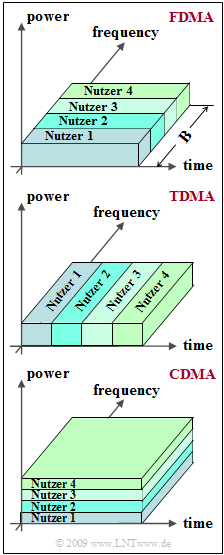Difference between revisions of "Aufgaben:Exercise 3.6: FDMA, TDMA and CDMA"
| Line 23: | Line 23: | ||
*Notes on the communication systems considered here can be found under the following links:<br> | *Notes on the communication systems considered here can be found under the following links:<br> | ||
| − | + | # [[Examples_of_Communication_Systems/Allgemeine_Beschreibung_von_GSM#.23_.C3.9CBERBLICK_ZUM_DRITTEN_HAUPTKAPITEL_.23|GSM]] (Global System for Mobile Communications), | |
| − | + | # [[Examples_of_Communication_Systems/Allgemeine_Beschreibung_von_UMTS#.23_.C3.9CBERBLICK_ZUM_VIERTEN_HAUPTKAPITEL_.23|UMTS]] (Universal Mobile Communications Systems), | |
| − | + | # [[Examples_of_Communication_Systems/Allgemeine_Beschreibung_von_DSL#.23_.C3.9CBERBLICK_ZUM_ZWEITEN_HAUPTKAPITEL_.23|DSL]] (Digital Subscriber Line). | |
| − | |||
| − | |||
| Line 74: | Line 72: | ||
'''(1)''' Correct is the <u>solution 2</u>: | '''(1)''' Correct is the <u>solution 2</u>: | ||
*FDMA, TDMA and CDMA are multiple access or multiplexing techniques, | *FDMA, TDMA and CDMA are multiple access or multiplexing techniques, | ||
| − | *which are then, however, abbreviated as FDM, TDM and CDM: | + | *which are then, however, abbreviated as FDM, TDM and CDM: "Frequency (Time, Code) Division Multiplexing"'. |
| Line 103: | Line 101: | ||
'''(5)''' Only <u>solution 1</u> is correct: | '''(5)''' Only <u>solution 1</u> is correct: | ||
| − | *For "Fast Internet" connections nowadays, it is common to use [[Examples_of_Communication_Systems/Allgemeine_Beschreibung_von_DSL#.23_.C3.9CBERBLICK_ZUM_ZWEITEN_HAUPTKAPITEL_.23|$\rm DSL$]] (Digital Subscriber Line). | + | *For "Fast Internet" connections nowadays, it is common to use [[Examples_of_Communication_Systems/Allgemeine_Beschreibung_von_DSL#.23_.C3.9CBERBLICK_ZUM_ZWEITEN_HAUPTKAPITEL_.23|$\rm DSL$]] ("Digital Subscriber Line"). |
| − | *This is based on [[Modulation_Methods/Allgemeine_Beschreibung_von_OFDM#Das_Prinzip_von_OFDM_.E2.80.93_Systembetrachtung_im_Zeitbereich|$\rm OFDM$]] (Orthogonal Frequency Division Multiplexing), which is an FDM version. | + | *This is based on [[Modulation_Methods/Allgemeine_Beschreibung_von_OFDM#Das_Prinzip_von_OFDM_.E2.80.93_Systembetrachtung_im_Zeitbereich|$\rm OFDM$]] ("Orthogonal Frequency Division Multiplexing"), which is an FDM version. |
*The individual spectra are not separated, however, but overlap. There is still no mutual influence due to the orthogonality. | *The individual spectra are not separated, however, but overlap. There is still no mutual influence due to the orthogonality. | ||
Revision as of 17:30, 24 February 2021
The diagrams illustrate the principle of
- Frequency Division Multiple Access $\rm (FDMA)$,
- Time Division Multiple Access $\rm (TDMA)$, and
- Code Division Multiple Access $\rm (CDMA)$.
The multiple access methods listed here are based on the assumption that there are several transmitter–receiver pairs that share a transmission medium independently.
On the other hand, multiplexing occurs when a multiplexer $\rm (MUX)$ bundles several signals at the beginning of transmission and a demultiplexer $\rm (DEMUX)$ splits the common signal at the end. In this case, FDM, TDM and CDM are abbreviated to "Frequency (Time, Code) Division Multiplexing".
The task is to determine which of these methods (FDMA/FDM, TDMA/TDM, CDMA/CDM) is used by some of today's most important communications systems (GSM, UMTS, DSL).
Notes:
- This task refers to the chapter Characteristics of UMTS.
- Notes on the communication systems considered here can be found under the following links:
- GSM (Global System for Mobile Communications),
- UMTS (Universal Mobile Communications Systems),
- DSL (Digital Subscriber Line).
Questionnaire
Solution
(1) Correct is the solution 2:
- FDMA, TDMA and CDMA are multiple access or multiplexing techniques,
- which are then, however, abbreviated as FDM, TDM and CDM: "Frequency (Time, Code) Division Multiplexing"'.
(2) Correct are the solutions 2 and 3:
- FDMA/FDM can also be used in analog systems, of which classical broadcasting (since the 1930s) is an example.
(3) Correct are the solutions 1 and 2:
- At mobile radio standard GSM, FDMA and TDMA are used.
- In the so-called "D-band" (uplink from $890$ to $915 \ \rm MHz$, downlink from $935$ to $960 \ \rm MHz$), there are $124$ FDMA channels of $200 \ \rm kHz$, taking into account the guard bands of $100 \ \rm kHz$ at the upper and lower end of the range in each direction.
- In the "E-band" (uplink: $1710 - 1785 \ \rm MHz$, downlink: $1805 - 1880 \ \rm MHz$), $374$ FDMA channels can be used.
- Time Division Multiple Access (TDMA) can be used to provide eight users additionally in each frequency band. A TDMA frame has a length of $4.615 \ \rm ms$, so that time slots of $0.577 \ \ \rm ms$ duration are available for each user in this time interval.
(4) Correct are the solutions 2 and 3:
- The UMTS variant "UMTS Terrestrial Radio Access - Frequency Division Duplex" $\text{(UTRA-FDD)}$ used exclusively in Germany consists of $12$ paired uplink and downlink frequency bands of $5 \ \rm MHz$ bandwidth each,
- between $1920 \ \rm MHz$ and $1980 \ \rm MHz$ (uplink) or
- between $2110 \ \rm MHz$ and $2170 \ \rm MHz$ (downlink).
- So you could definitely speak of an $\rm FDMA$ system. However, the various $5 \ \rm MHz$ bands are used by other network operators.
- If, on the other hand, one considers a $5 \ \rm MHz$ band on its own, UMTS does not have an FDMA component. In each of the bands, $\rm CDMA$ is implemented instead, so that up to $512$ users can be active simultaneously in each frequency band. And to some extent $\rm TDMA$ (time slots, frames, TTI) is also used.
(5) Only solution 1 is correct:
- For "Fast Internet" connections nowadays, it is common to use $\rm DSL$ ("Digital Subscriber Line").
- This is based on $\rm OFDM$ ("Orthogonal Frequency Division Multiplexing"), which is an FDM version.
- The individual spectra are not separated, however, but overlap. There is still no mutual influence due to the orthogonality.
